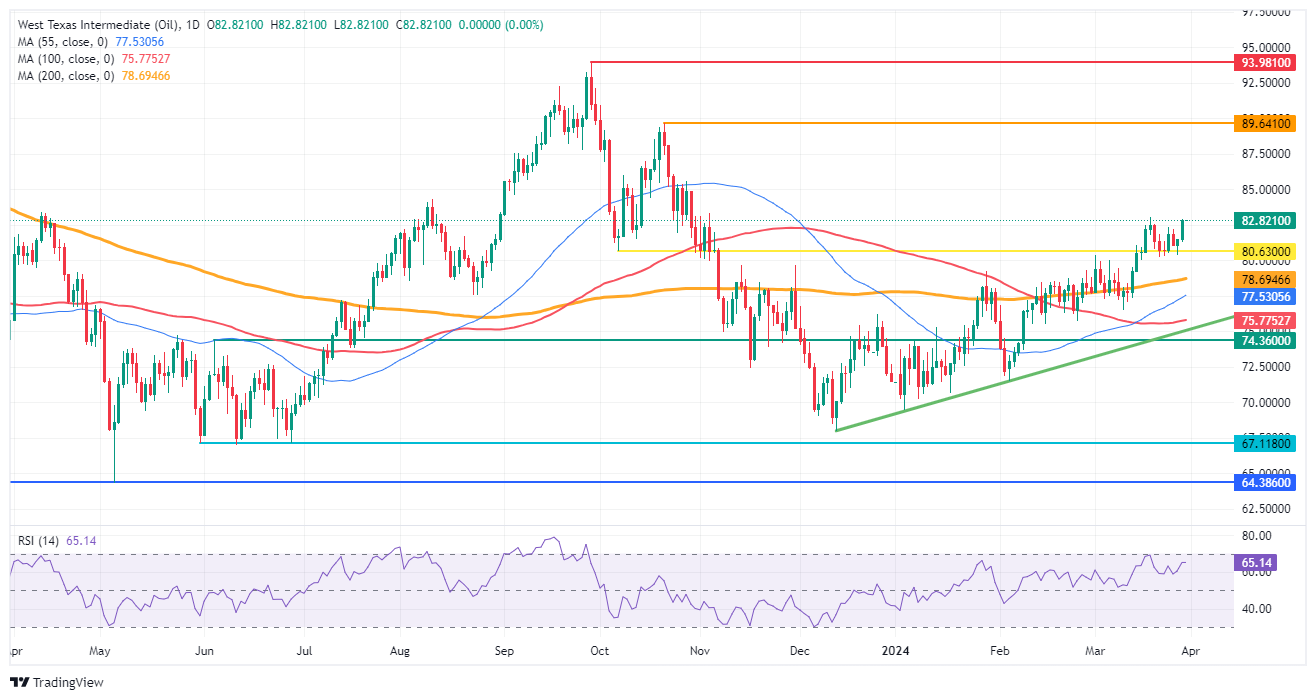- WTI oil closed Thursday at $82.82, near a new five-month high.
- Oil traders remain bullish despite the recent buildup of reserves in the United States.
- The US Dollar Index DXY is trading positive and could record a new monthly high.
Oil prices have risen in recent weeks, with several elements painting an unclear picture of the US situation in the global oil market. The bearish moves in recent weeks were often attributed to the fact that the US was flooding oil markets to moderate prices. However, Bloomberg reports that the US Department of Energy is buying oil at current prices to rebuild US strategic reserves, which have been at 40-year lows, meaning the US is dumping oil to lower prices while buying back that same oil at a higher price.
The US Dollar, for its part, is roaring again with the US Dollar bulls putting together a four-day winning streak following the US Personal Consumption Expenditures (PCE) Price Index numbers. vilo, as the latest inflation measurements have pointed to a rebound in price pressures. Markets could begin to trim the number of interest rate cuts planned for this year, further rolling back the US Federal Reserve's initial rate cut.
Crude oil (WTI) closed at $82.82 per barrel, and Brent at $86.82 per barrel on Thursday afternoon.
Oil could rise towards $90 if US attempts fail to overcome OPEC production cuts
- Next Wednesday, OPEC will meet to discuss and decide on current production cuts. Saudi Arabia is expected to extend its part until the end of the year.
- Despite Easter Monday, the US Energy Information Administration will publish on Wednesday, as usual, the changes in US reserves for this week.
- The American Petroleum Institute will release regular inventory figures on Tuesday.
Technical analysis of the price of oil: Increase in US strategic reserves
Oil prices are about to rise as the game between the US and OPEC appears to be falling in favor of the oil cartel. The US cannot oversupply oil markets as it is unable to match production cuts from Saudi Arabia and Russia. By being forced to replenish its strategic reserves, the US is paying a dear price in its economic war with Russia and OPEC, while creating a second round effect on US inflation with prices at Gas pumps that remain fragile for increases.
Oil bulls will see $86 appear as the next top. Further up, $86.90 is another resistance before targeting $89.004 and $93.98 as highs.
To the downside, both $80.00 and $80.60 should act as support, with the 200-day SMA as a level to catch any declines near $78.55. The 100-day and 55-day SMAs are near $75.64 and $77.15, respectively. If we add to this the fundamental level near $75.27, it seems that the downtrend is very limited and well prepared to resist the selling pressure.
US WTI crude oil daily chart
WTI Oil FAQ
What is WTI oil?
WTI oil is a type of crude oil that is sold in international markets. WTI stands for West Texas Intermediate, one of the three main types that include Brent and Dubai crude. WTI is also known as “light” and “sweet” for its relatively low gravity and sulfur content, respectively. It is considered a high-quality oil that is easily refined. It is sourced in the United States and distributed through the Cushing facility, considered “the pipeline junction of the world.” It is a benchmark for the oil market and the price of WTI is frequently quoted in the media.
What factors determine the price of WTI oil?
Like all assets, supply and demand are the main factors that determine the price of WTI oil. As such, global growth can be a driver of increased demand and vice versa in the case of weak global growth. Political instability, wars and sanctions can alter supply and impact prices. The decisions of OPEC, a group of large oil-producing countries, is another key price factor. The value of the US Dollar influences the price of WTI crude oil, as oil is primarily traded in US dollars, so a weaker Dollar can make oil more affordable and vice versa.
How do inventories influence the price of WTI oil?
Weekly oil inventory reports published by the American Petroleum Institute (API) and the Energy Information Agency (EIA) influence the price of WTI oil. Changes in inventories reflect the fluctuation of supply and demand. If the data shows a decline in inventories, it may indicate an increase in demand, which would drive up the price of oil. An increase in inventories can reflect an increase in supply, which drives down prices. The API report is published every Tuesday and the EIA report the next day. Their results are usually similar, with a difference of 1% between them 75% of the time. EIA data is considered more reliable since it is a government agency.
How does OPEC influence the price of WTI oil?
OPEC (Organization of the Petroleum Exporting Countries) is a group of 13 oil-producing nations that collectively decide member countries' production quotas at biannual meetings. Their decisions often influence WTI oil prices. When OPEC decides to reduce quotas, it can restrict supply and drive up oil prices. When OPEC increases production, the opposite effect occurs. OPEC+ is an expanded group that includes ten other non-OPEC member countries, including Russia.
Source: Fx Street
I am Joshua Winder, a senior-level journalist and editor at World Stock Market. I specialize in covering news related to the stock market and economic trends. With more than 8 years of experience in this field, I have become an expert in financial reporting.








